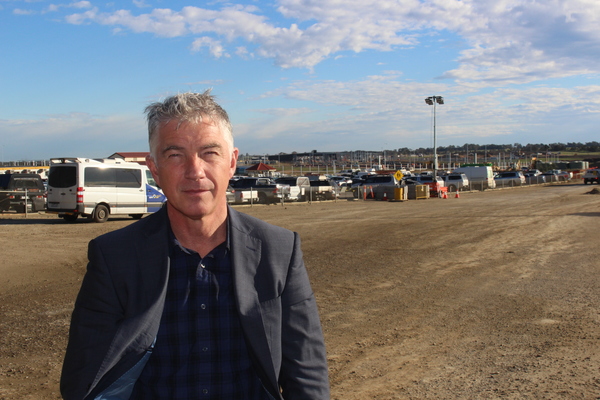
By Rowan Forster
Metro’s behemoth train stabling yard at Pakenham East has been labelled a “looming disaster”, with 34 high-capacity trains set to enter Melbourne’s rail network at the “already bursting” Racecourse Road level crossing four times per day.
Council planners estimate it will equate to an additional 10 crossings at the thoroughfare every hour during morning and afternoon peaks.
With boom gates closed for roughly two minutes per crossing, traffic will be brought to a screeching halt for approximately 20 minutes of every hour during the morning rush.
Racecourse Road is currently the only access point between the Princes Freeway and the heart of Pakenham not inhibited by metropolitan train crossings, with V\Line services only passing every 50 minutes.
Bass MP Brian Paynter said it will be an “absolute nightmare” for commuters.
“This is going to be a massive disaster for Racecourse Road commuters – and essentially all commuters in Pakenham because of the flow on effect,” he said.
“These 34 high capacity trains will be put into the system during peak hour traffic and then they have to get back to the stabling centre for maintenance, cleaning and service.
“The entire area – including the Bald Hill Road roundabout – is already a nightmare and it will only get much, much worse.
“These level crossings need to be removed.”
In peak hour, when the Racecourse Road boom gates lower, traffic banks back past Bald Hill Road and as far back as the Princes Freeway off-ramp.
It is feared once drivers become aware of the increased train traffic at Racecourse Road’s level crossing, they will instead use McGregor Road or Cardinia Road – further spreading congestion across the suburb.
Melbourne Rotomould co-director Tim Leed, whose business is located at Bormar Drive, described the state of Racecourse Road as an “absolute joke”.
He fears the thoroughfare will become “beyond manageable” when Pakenham East’s stabling yard begins to operate.
“In the morning, there’s a V/Line train at 8.30 and Racecourse Road banks up to the Princes Freeway,” he said.
“It’s just going to make it that much worse.
“From about 2.30pm, it consistently takes 10 minutes to get from Bormar Drive to the roundabout which is a distance of 800 metres.
“It’s quicker to walk.”
According to VicRoads data, more than 22,000 vehicles use Racecourse Road per day – more than many roads in metropolitan Melbourne where level crossings have been removed.
Council’s general manager of planning and development Andrew Paxton said Cardinia Shire have pressured the State Government to have the crossings upgraded. “Council shares the community’s concerns that already congested roads will be further impacted by increased frequency of trains at key crossings, as well as the impacts of congestion on safety, time away from family and the home, and the costs of doing business,” he said.
“We continue to advocate to the Victorian Government for improved public transport for our community, however this needs to be complemented by infrastructure to support this.
“Council is advocating for improved road networks, including grade separations to eliminate level crossings at these key junctions, freeway ramps at McGregor Road, Officer South Road, and Beaconsfield and an upgrade to Racecourse Road from the highway to South East Boulevard, before traffic atPakenham South increases further.
“Council has already secured the road reserves and done everything we can to ensure plans could progress if the Victorian Government commits to the requested improvements.”
When asked by the Gazette if the State Government would commit to remove Pakenham’s level crossings, Transport Minister Jacinta Allan said it would “be considered” at a later date.
“We’re very busy getting rid of level crossings across Melbourne and upgrading infrastructure along the Pakenham line,” she said.
“The more modern signalling systems we are installing will streamline the network and allow these trains – which will increase patron capacity by 42 per cent – to run.
“These new high capacity trains will do the heavy lifting on the Cranbourne-Pakenham lines, ahead of the opening of the Metro Tunnel, enabling more passengers to travel during the busiest parts of the day.”
The 118-hectare facility will include maintenance facilities and a train simulator.
It will be built with 87 per cent local content – creating 400 jobs during construction and supporting 100 skilled ongoing jobs once the facility is operational.







